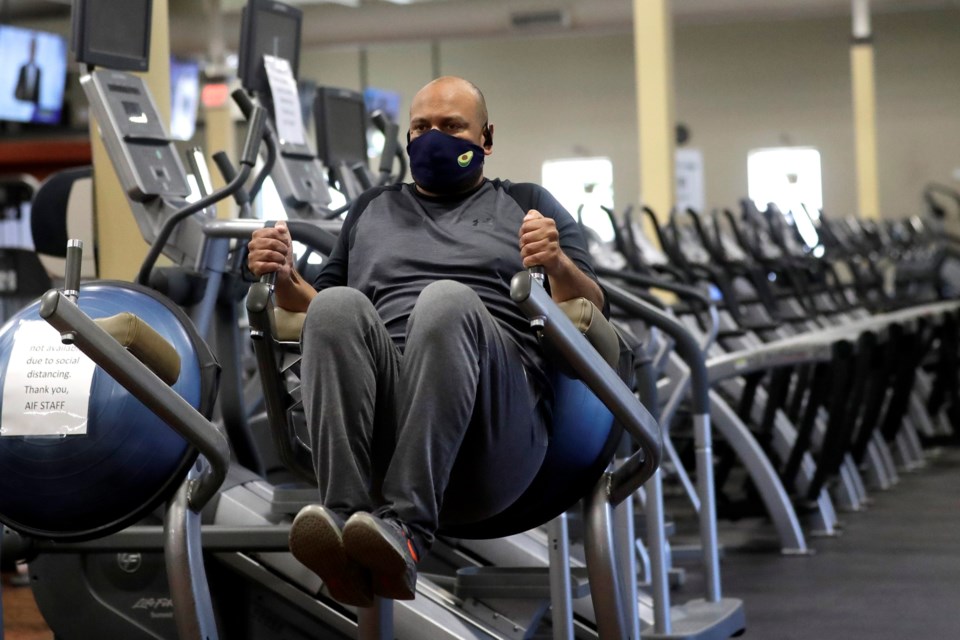Gym owners warn that it won't be fitness as usual as many Ontario facilities implement new measures to keep members safe while they get back in shape after months of COVID-19 languor.
Fitness centres in much of Ontario are set to reopen Friday as part of Stage 3 of the government's COVID-19 restart plan. However, exercise enthusiasts in regions stuck in Stage 2, such as Toronto and Peel, will have to sweat it out on their own for a bit longer.
Provinces including British Columbia, Alberta and Quebec have made similar moves to resume indoor physical activities after the pandemic shuttered recreation facilities in March.
However, many fitness buffs may find their routines are disrupted by pre-workout screenings, slashed class sizes, off-limits equipment and reduced amenities as gyms beef up their cleaning protocols and trim down services in an effort to prevent the spread of the novel coronavirus.
Ashleigh Tuite, an infectious disease epidemiologist at University of Toronto, said without proper safety measures, gyms can create "ideal" conditions for COVID-19 infection.
The virus is spread through respiratory droplets, which are exhaled through coughing, sneezing or heavy breathing, said Tuite. If a sick person is huffing and puffing through a workout, it's possible that these viral particles may have a farther reach, she said.
The risk of transmission is higher indoors, said Tuite, particularly in crowded spaces with poor ventilation. Gyms are also filled with high-contact areas, so with every barbell a person lifts, their chance of touching a contaminated surface increases.
These hazards vary depending on COVID-19 rates in the community, the size of the gym and the intensity of exercise, she said.
However, Tuite said there are steps gym-goers and owners can take to reduce people's chances of contracting the virus while working off pandemic-induced weight gain.
She said fitness centres can improve airflow by opening windows or installing new ventilation systems, and members also have a role to play in maintaining physical distance and disinfecting equipment before and after use.
Fitness Industry Council of Canada president Scott Wildeman said the trade association's members, which include boutique studios to "big box" gyms, are marshalling their resources to keep Canadians fit and virus-free.
Some of these measures are government-mandated, Wildeman said. For example, in Ontario, fitness centres have to ensure members can maintain a two-metre distance and cap capacity at the indoor gathering limit of 50 people.
Some jurisdictions also require that staff and clients wear masks while moving through the facilities, he said. But public health officials recommend that people remove their masks before getting their heart rates up, because the protective gear can inhibit comfortable breathing.
Many gyms have had to curtail services to keep up with public health protocols and enhanced cleaning regimens, said Wildeman.
He said many clubs have implemented booking systems so members don't have to wait to get their workout in. But not everyone is ready to return just yet, he acknowledged.
In provinces that have reopened gyms, the council's data suggest that roughly 60 per cent of members return within the first month, and attendance increases from there, said Wildeman.
Even as their costs have increased, most fitness centres are trying to be flexible about requests to freeze or cancel memberships, he said. Some are playing around with pricing, or supplementing their offerings with virtual workouts.
"Online is great, because it's very convenient and accessible," he said. "But nothing really replaces the community and the camaraderie of a gym."
GoodLife Fitness has already reopened 74 locations across Canada, and 44 more will get back to the grind on Friday, said Jason Sheridan, senior vice-president of operations.
Returning members will notice some differences, he said. Every hour, the club will be "reset" to allow staff to disinfect each area before the next member uses it.
Change rooms have been cleared of hair dryers and curling irons, and showers are prohibited at many clubs.
The fitness chain has suspended towel service, and members are asked to bring their own mats and props to classes.
Sheridan said the group fitness schedule has been limited to workouts that allow people to keep to their own space, such as yoga and spinning, rather than dance-style classes where people move around the room.
Orangetheory Fitness Canada president Blake MacDonald said the high-intensity exercise franchise has shortened classes to 45 minutes from an hour to allow extra time for cleaning. Clients are also asked to arrive no early than 10 minutes before their sweat session starts to avoid any overlap with the next class.
Sweat and Tonic, a boutique studio in downtown Toronto, has overhauled its three-floor facility in hopes that it will soon be able to welcome back fitness fanatics, said social media and marketing manager Sharon Xie.
Plexiglass dividers have been installed between every treadmill, stationary bike and yoga station. The studio has also upgraded its air filtration to trap fine particles more effectively.
Patrons will also have to disinfect their shoes and pass a temperature check before they enter, and filter in and out of class one row at a time, Xie said. And to compensate for scaled-down services, the studio has reduced its monthly membership fee to $275 from $250.
Connie Cornelius, a personal trainer and owner of Area Fitness in east-end Toronto, said most of the club's members are staying active outdoors, but she warns that it may take some time for people to ease back into their gym routines before lifting their max weight.
Similarly, Cornelius is training her clients to wear masks while working out by gradually building up aerobic intensity and taking breaks between sets.
"I don't think anyone should just jump back into anything," she said. "You want to be a little kinder to yourself."
This report by The Canadian Press was first published July 16, 2020.
Adina Bresge, The Canadian Press




